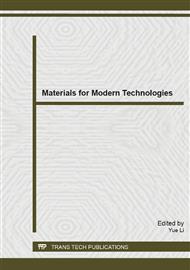[1]
Jae-Hwan Park, Young-Jin Choi, Jeong-Hyun Park, Low-fire dielectric compositions with permittivity 20–60 for LTCC applications, mater. chem. phys. 88(2004)308-312.
DOI: 10.1016/j.matchemphys.2004.07.016
Google Scholar
[2]
Seong-Jin Hwang, Yu-Jin Kim, Hyung-Sun Kim, La2O3–B2O3–TiO2 Glass/BaO–Nd2O3–TiO2 ceramic for high quality factor low temperature co-fired ceramic dielectric,J. Electroceram. 18(2007)121-128.
DOI: 10.1007/s10832-007-9014-9
Google Scholar
[3]
Chen Zhang, Ruzhong Zuo, Qian Sun, Microwave dielectric properties and low temperature sintering of the ZnO-V2O5 doped Ba3Ti2(Mg1/3Nb2/3)2Nb4O21 ceramics, Ceramics International. 39(2013)5675–5679.
DOI: 10.1016/j.ceramint.2012.12.084
Google Scholar
[4]
Hsing-I. Hsiang, Chi-Shiung Hsi, Chun-Chi Huang, Low temperature sintering and dielectric properties of BaTiO3 with glass addition, mater. chem. phys. 113(2009) 658.
DOI: 10.1016/j.matchemphys.2008.08.033
Google Scholar
[5]
Shin-Tae Bae, Sangwook Lee, Jin Ho Kin, Effect of Glass Composition on the Dielectric Properties of a Liquid- Phase-Sintered MgO-Doped BaTiO3, J. Am. Cerami. Soc. 91(2008) 2205-2210.
DOI: 10.1111/j.1551-2916.2008.02435.x
Google Scholar
[6]
Y J Wu, XM. Chen, Bismuth /Samarium cosubstituted Ba6-3xNd8+2xTi18O54 microwave dielectric ceramics, J. Am. Ceram. Soc. 83(2000)1837-1839.
DOI: 10.1111/j.1151-2916.2000.tb01478.x
Google Scholar
[7]
S B Narang, D. Kaur, S. Bahel, Dielectric properties of lanthanum substituted barium titanate microwave ceramics, mater. lett. 60(2006)3179-3182.
DOI: 10.1016/j.matlet.2006.02.079
Google Scholar
[8]
Nijesh Kunnamkuzhakal James, Ravendran Ratheesh, Ravendran Ratheesh, Microwave Dielectric Properties of Low-Temperature Sinterable BaCe2(MoO4)4 Ceramics, J. Am. Ceram. Soc. 93(2010)931–933.
DOI: 10.1111/j.1551-2916.2009.03508.x
Google Scholar
[9]
Tony Joseph, Mailadil T. Sebastian, Effect of Glass Addition on the Microwave Dielectric Properties of CaMgSi2O6 Ceramics, Int. J. Appl. Ceram. Technol. 7(2010)E98–E106.
DOI: 10.1111/j.1744-7402.2009.02439.x
Google Scholar
[10]
Prabhakaran Sreekumari Anjana, Isuhak Naseema Jawahar, Low loss, temperature stable dielectric ceramics in ZnNb2O6–Zn3Nb2O8 system for LTCC applications, J Mater Sci: Mater Electron. 20(2009)587-596.
DOI: 10.1007/s10854-008-9770-6
Google Scholar
[11]
Dae Min Kim, Shin Kim, Kwan Soo Kim, Low-temperature sintering and dielectric properties of the Bi(Nb1−xTax)O4 system, J Electroceram. 23(2009)164-168.
DOI: 10.1007/s10832-007-9350-9
Google Scholar
[12]
A. M. Hu, K. -M. Liang, F. Peng, Crystallization and Microstructure Changes in Fluorine-Containing Li2O–Al2O3–SiO2 Glasses, Thermochim. Acta. 413(2004)53-55.
DOI: 10.1016/j.tca.2003.10.025
Google Scholar


